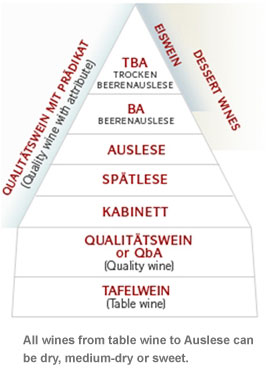|
|
| Pyramid of German Wine Quality Measures |
| |
 |
The most unique characteristic of German wine is its use of a hierarchy measuring quality based on the grape's natural sugar level at harvest. Among the most important legally required declarations on a label is a wine's quality category. The German wine law makes far more distinctions within the two broad quality categories mandated by the European Union wine law �C table wine and quality wine - than other wine-growing countries.
The ripeness of the grapes at harvest time is a key factor to a wine's quality category. One indication of ripeness is an increasing amount of natural sugar in the grape juice or must. The riper the grapes, the higher the amount of natural sugar in their juice (measured as «must weight» in degrees Oechsle) and, hence, the greater the potential quantity of natural alcohol in a wine. The wine law has established legal minimum amounts of natural alcohol that a wine must achieve in order to qualify for a specific quality category.
It is important to remember that predicate quality designations are based on the ripeness of grapes at the time of harvest, not on the amount of |
residual sugar in the wine at the time of bottling. The same grape variety can produce anything from bone dry to sweet dessert wines. If a wine is dry, the label will read "Trocken" regardless of the quality level of the wine. It is also possible to label a wine as "Halbtrocken" (half-dry, semi-dry). Halbtrocken wines are semi-dry, falling between Trocken (dry) and the traditional sweeter Kabinett style wines.
German wine quality measure system is classified into two major quality categories: QbA and QmP. A table wine category does exist at the bottom of the scale (Tafelwein or Landwein), but its total production (0.3 million hl in 2005, according to the German Wine Institute) is dwarfed by the two larger quality categories and very seldom exported to markets outside Germany.
The table wine category (wines made from normally ripe grapes) comprises two levels in Germany:
• Deutscher Tafelwein (simple table wine)
• Deutscher Landwein (superior table wine)
The quality wine category (wines made from ripe, very ripe or overripe grapes) comprises two levels in Germany. These wines are subject to a quality control examination and must bear a quality control test number (A.P.Nr.) on the label:
• Qualitätswein bestimmter Anbaugebiete, abbreviated QbA
• Qualitatswein mit Prädikat, abbreviated QmP
Additional Category, Sparkling Wine (Sekt Wine)
There is a special category of wine German Sparkling Wine (Sekt Wine) which is not included in this Pyramid of Quality Measure System.
Germany has the highest per capita consumption of sparkling wine in the world and sparkling wine is drank at every occasion and also commonly served as an aperitif.
While most of Sparkling Wine is produced by large sparkling wine houses and caters to the mass market, there are many vintners that produce small quantities of racy Sparkling Wine, made according to the traditional champagne method. Most commonly, the grape used is Riesling, but some vintners have been very successful with Chardonnay and Ros�� style sparklers made from Pinot Noir.
German Sparkling Wine (Sekt Wine) made according to the champagne method undergoes a second fermentation in the bottle and hand riddled over the course of 18-24 months. It is vivacious, clean and more aromatic than its cousins from the Champagne region of France. The most common styles are Extra Brut (very dry), Brut (dry) and Trocken (off dry), but sweeter styles are made as well (demi-sec or doux). These high quality sparkling wines are very hard to find outside of Germany.
|
|
|
|

